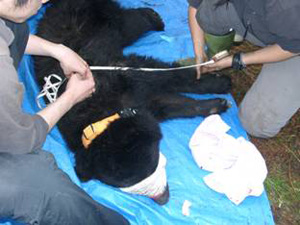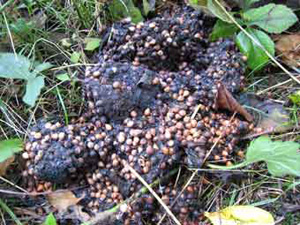研究紹介 Research theme
主要な研究成果をご紹介します。各論文の詳しい情報は、「研究の成果」のページを参照してください。
1. クマの行動追跡テクニック A technique for tracking the movement and behavior of Asian black bears

従来のVHFテレメトリーに代わる野生動物の行動追跡手法として、GPSテレメトリーが2000年以降に実用化されました。私たちは、日本で初めてクマの行動研究にこのシステムを取り入れ、実用面での評価を行うと共に(Yamazaki et al. 2008a)、国内外のメーカーと協働しながら、機材の改善や開発に取り組んでいます(山﨑ほか2008c)。GPS首輪に内蔵されるセンサー類から活動状態等を判別できることも明らかにしました(Kozakai et al. 2008, Yamazaki et al. 2008b, Fuchs et al. 2019)。この他、個体間の血縁関係をDNA解析によって調べるなど、あらゆる角度からクマの行動に迫っています (Kozakai et al. 2017)。
Since 2000, GPS telemetry has been used as a technique for tracking the movement and behavior of wild animals instead of the conventional very high frequency (VHF) telemetry technique. For the first time in Japan, we have introduced this technique in our research on the movement and behavior of Asian black bears (Ursus thibetanus) for evaluation of its practicality (Yamazaki et al. 2008a). In addition, we have attempted to improve the existing equipment and develop new equipment in collaboration with manufacturers within and outside Japan (Yamazaki et al. 2008b). Moreover, we have clarified that the behavior of bears could be determined based on data obtained from the sensors incorporated in a GPS collar (Kozakai et al. 2008, Yamazaki et al. 2008c, Fuchs et al. 2019). Furthermore, we investigated the movement and behavior of bears in all aspects, for example, the study of the kin relationship using DNA analysis (Kozakai et al. 2017).
2. 森林生態系における、種子散布者としてのクマ Bears as seed dispersers in forest ecosystems

行動を追いかけることで、森林生態系においてツキノワグマが種子散布者として機能していることを明らかにしました (Koike et al. 2008a, b)。ツキノワグマがサクランボなどの液果を採食した際には、ほとんどの種子は発芽能力を持った状態で糞として排泄されます。さらに、ツキノワグマの糞に含まれる種子はネズミ類や糞虫類の2次散布によって、発芽に適した環境に移動します (Koike et al. 2006, 2012a, b)。また、ツキノワグマは他の種子散布者より種子を長距離散布することが分かっており、その距離は20kmを越える可能性があります (Koike et al. 2011)。
By tracking the movement and behavior of the Asian black bears, we observed that they play a role as seed dispersers in forest ecosystems. Bears consume fleshy fruits, such as cherries; the seeds of these fruits are defecated in their feces, and most of these seeds exhibit germinability (Koike et al. 2008a, b). In addition, the seeds in the feces defecated by bears will be transported to an environment suitable for germination by secondary seed dispersers, such as rodents or dung beetles (Koike et al. 2006, 2012a, b). Furthermore, bears can disperse seeds over a longer distance, probably >20 km, compared with the other seed dispersers (Koike et al. 2011).
3. ブナ科堅果類の豊凶を調べる Estimation of the production of the hard mast of Fagaceae

ツキノワグマにとって秋は冬眠に備えるための重要な季節です。秋の主食であるブナ科堅果類(ドングリ)は、結実が豊作の年と凶作の年を定期的に繰り返すとともに、広範囲で個体間で結実の程度が同調する、いわゆる結実豊凶があるという特徴があります。従って、秋のクマの生活を知るには、ブナ科堅果類の結実量を調査する必要があります。私たちは2006年から毎年、足尾・日光地域において堅果類に液果類も加えた8種約600本の果実の結実量を定量的に調査し、この長期観察データを活かして、クマの行動との関係解明に挑んでいます(Nakajima et al. 2015)。
Autumn is an important season for the Asian black bears because they prepare for hibernation. The hard mast of Fagaceae exhibit a phenomenon called masting, wherein the fruit production cycles through the good and poor masting years is synchronized among individual trees located over a wide range. Therefore, to investigate the ecology of bears in autumn, it is necessary to clarify the status of hard mast production. Since 2006, we have quantitatively investigated the annual fruit production of approximately 600 individuals of 8 tree species in the Ashio-Nikko Mountain (Nakajima et al. 2015). Using our long-term observation data, we have attempted to elucidate the relationship between the ecology of bears and fruit production.
4. ブナ科堅果類の豊凶とクマの行動との深い関係 Close relationship between masting and the ecology of bears
堅果類の豊凶に応じて、ツキノワグマの行動が大きく変化することを明らかにしてきました。冬眠の準備に備えた食欲亢進期は毎年8月下旬から始まり、たとえ堅果の不作年であっても1日の活動時間をどんどん増やして(Kozakai et al. 2013)、広範囲に餌を探し回ります(Kozakai et al. 2011)。一般に哺乳類のメスは出生地に留まる傾向があり、ツキノワグマも春~夏には毎年ほぼ同じ場所で暮らしていますが(Kozakai et al. 2017)、不作年の秋だけは別です。オスだけでなくメスも長距離を移動しながら(Koike et al. 2012)、堅果の実りがある場所を探し回ります(根本ら2016)。しかし、不作年は長距離の移動、探索に見合うだけのエネルギーを獲得できていないようで、豊作年よりも早い時期に冬眠に入ることなども明らかにしました(Kozakai et al. 2013, Umemura et al. 2018, Furusaka et al. 2019)。
We clarified that the ecology of the Asian black bears greatly changed depending on hard mast production. During the period of increased appetite (hyperphagia) that starts from August, bears increasingly extended their activity time every day to search for nuts and acorns in a wider range, even in poor masting years, to prepare for hibernation (Kozakai et al. 2011, 2013). Typically, female mammals tended to stay at their natal area, and Asian black bears inhabited almost the same places from spring to summer every year, with the exception of autumn in the poor masting years (Kozakai et al. 2017). Male and female bears, in their search for the harvest areas with an abundance of hard mast, travel over long distances (Kozakai et al. 2011, Koike et al. 2012, Nemoto et al. 2016). However, we observed that compared with in good masting years, in the poor masting years, they enter hibernation earlier, probably because they cannot acquire sufficient energy to travel over long distances in search of foods (Kozakai et al. 2013, Umemura et al. 2018, Furusaka et al. 2019).
5. 年輪幅から個体群動態を把握! Understanding the bear population dynamics based on the annuli width of tooth cementum

クマの歯の根元にあるセメント質という部分に、木の年輪と同じように一年ごとの成長線が刻まれています。この年輪を数えることで年齢を知ることができますが、年輪の幅(以下、年輪幅)には動物の栄養状態も反映されることが分かっています。そこで、堅果類の豊凶と「オス」のクマの年輪幅との関係を調べてみましたが、当初の予想に反して不作年に年輪幅が狭くなることはありませんでした(Tochigi et al. 2019)。一方でメスでは、子どもを連れている年の年輪幅が、連れていないメスよりも狭くなっていることを突き止め、メスの育児成功の有無を年輪幅から把握できることを明らかにしました(Tochigi et al. 2018b)。現在、メスにおける堅果類の豊凶との関係解明を進めています。これらの知見は、クマの個体群動態を把握するための非常に重要な基盤情報となります。
The growth lines called annuli are annually formed in the cementum deposited at the tooth root of the Asian black bears. Counting the annuli reveals the age of a bear. Any nutritional change in animals is typically reflected in the width of the annuli (hereafter referred to as annuli width). We have investigated the relationship between the masting condition and annuli width in male bears (Tochigi et al. 2019). However, remarkably, the results showed that the annuli width did not become narrower during the poor harvest years. By contrast, we noted that the annuli widths of female bears who were raising cubs become narrower during this nurturing period compared with those of female bears who did not raise their cubs (Tochigi et al. 2018b). Therefore, based on the annuli width, it can be elucidated whether female bears have successfully raised their cubs. Currently, we are developing a research to elucidate the relationship between the masting condition and annuli width in female bears. The data obtained from this research will provide valuable basic information in understanding bear population dynamics.
6. 夏のクマって何をしているの? How do bears behave in summer?
ここまでご紹介してきたように、秋のクマの生態は、私たちのチームの研究成果を含め、各地で実施されている研究によって徐々に明らかになってきました。しかし、「非」食欲亢進期である春から夏のクマの振る舞いについては、まだ分からない点が多くあります。
そんな夏のクマについて、私たちは、調査地の1つである足尾・日光山地のクマが夏に高頻度で利用する社会性昆虫である「アリ類」の食物としての評価を試みました。その結果、クマはアリ類のフェノロジーに併せて、特に女王アリの出現時期に効率的な採食戦略をとることが分かりました(Fujiwara et al. 2013)。しかし,栄養的な評価では、クマがどれほど頑張ってアリ類を摂食しても、十分なカロリーを得ることは難しいことが示され、微量物質である(クマによっての)必須アミノ酸などを求めてアリを食べている可能性も考えられました(Yamazaki et al. 2012)。
As mentioned above, the research findings, including our results, have gradually clarified the ecology of bears in autumn. However, several aspects regarding the behavior of bears during the period from spring to summer remain unclear. To elucidate the behavior of bears in summer, we evaluated ants (of the family Formicidae) as food for bears in the Ashio-Nikko Mountain, which is one of our survey areas. Ants are a kind of social insects that are frequently consumed by bears in summer. Results demonstrated that bears adopt a strategy for efficient feeding that is consistent with the ant’s phenology, particularly with regard to the appearance of the queen ants (Fujiwara et al. 2013). However, a nutritional evaluation revealed that it is difficult for bears to acquire sufficient calorie intake despite feeding on ants, suggesting that they consume ants for essential amino acids, which are the trace nutrients required for bears (Yamazaki et al. 2012).
7. クマの体内(生理学)からも行動・生態の謎に迫る In vivo (physiological) inquiry into the unexplained ecology of bears
クマの生態を理解する上で,クマ体内で起こっている環境への応答を理解することも重要です。国内の大学、研究機関に加え、北欧やアメリカの大学などと協働で、野生クマの生理に関する研究に着手しています。繁殖に関わるパラメーターである性ホルモンの測定や、代謝に関わる生理的項目の測定です。現在は、最新の生理ロガー類を用いて、クマの心拍や体温に関する一年を通したデータの取得、蓄積を行っています。同時に、非侵襲的な手法を用いたクマのボディ・コンディションの計測にも挑戦しています。これまでに、心拍の挙動に、日本のツキノワグマと北欧のヒグマで顕著な違いがあることがわかり、その違いは食物の相違、つまりは食欲亢進期の発動の違いに起因することが示されました(Fuchs et al. 2019)。
To understand the ecology of bears, it is important to elucidate their body responses to the environment. We are engaged in a study of the physiology of wild bears in collaboration with the universities and other similar organizations in northern Europe and the United States as well as with the universities and research institutions in Japan. In this study, sex hormones, which are the parameters involved in reproduction, and physiological items related to metabolism are measured. Currently, the latest loggers and monitors are used to collect and accumulate physiological data in terms of the heart rate and body temperature of bears throughout the year (Fuchs et al. 2019). Moreover, we are attempting to measure their body conditions using a noninvasive technique. Results of the measurements obtained to date have demonstrated a marked difference in heart rate behavior between the Asian black bears in Japan and brown bears in northern Europe, suggesting that the difference is caused by differences in food availability, particularly a difference in activation timing of hyperphagia.

